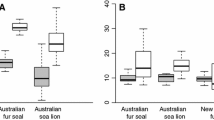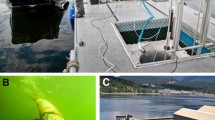Abstract
Measurements of routine swimming speed, “tail-flip” escape responses, and oxygen consumptions were made of the deep-sea shrimp Acanthephyra eximia using autonomous landers in the Rhodos Basin at depths of up to 4,400 m and temperatures of 13–14.5°C. Routine swimming speeds at 4,200 m averaged 0.18 m s−1 or 3.09 body lengths s−1, approximately double those of functionally similar oceanic scavengers. During escape responses peak accelerations of 23 m s−2 or 630.6 body lengths s−2 were recorded, with animals reaching speeds of 1.61 m s−1 or 34.8 body lengths s−2. When compared to shallow-water decapods at similar temperatures these values are low for a lightly calcified shrimp such as A. eximia despite a maximum muscle mass specific power output of 90.0 W kg−1. A preliminary oxygen consumption measurement indicated similar rates to those of oceanic crustacean scavengers and shallower-living Mediterranean crustaceans once size and temperature had been taken into account. These animals appear to have high routine swimming speeds but low burst muscle performances. This suite of traits can be accounted for by high competition for limited resources in the eastern Mediterranean, but low selective pressure for burst swimming due to reductions in predator pressure.



Similar content being viewed by others
References
Albertelli G, Arnaud PM, Della Croce N, Drago N, Eleftheriou A (1992) The deep Mediterranean macrofauna caught by traps and its trophic significance. C R Acad Sci Paris Sér III 315:139–144
Angilletta MJ, Wilson RS, Navas CA, James RS (2003) Tradeoffs and the evolution of thermal reaction norms. Trends Ecol Evol 18:234–240
Arnott SA, Neil DM, Ansell AD (1998) Tail-flip mechanism and size dependent kinematics of escape swimming in the brown shrimp Crangon crangon. J Exp Biol 201:1771–1784
Bailey DM, Jamieson AJ, Bagley PM, Collins MA, Priede IG (2002) Measurement of in situ oxygen consumption of deep-sea fish using an autonomous lander vehicle. Deep Sea Res I 49:1519–1529
Bailey DM, Bagley PM, Jamieson AJ, Collins MA, Priede IG (2003) In situ investigation of burst swimming and muscle performance in the deep-sea fish Antimora rostrata. J Exp Mar Biol Ecol 286:295–311
Britton JC, Morton B (1994) Marine carrion and scavengers. Oceanogr Mar Biol Annu Rev 32:369–434
Carrassón M, Matallanas J (2001) Feeding ecology of the Mediterranean spiderfish, Bathypterois mediterraneus (Pisces: Chlorophthalmidae), on the western Mediterranean slope. Fish Bull 99:266–274
Carrassón M, Matallanas J (2002) Diets of deep-sea macrourid fishes in the western Mediterranean. Mar Ecol Prog Ser 234:215–228
Cartes JE, Maynou F (1998) Food consumption by bathyal decapod crustacean assemblages in the western Mediterranean: predatory impact of megafauna and the food consumption-food supply balance in a deep-water food web. Mar Ecol Prog Ser 171:233–246
Childress JJ (1995) Are there physiological and biochemical adaptations of metabolism in deep-sea animals? Trends Ecol Evol 10:30–36
Christiansen B (1989) Acanthephyra sp. (Crustacea: Decapoda) in the Eastern Mediterranean Sea captured by baited traps. Senkenbergiana Marit 20:187–193
Collins MA, Priede IG, Bagley PN (1999) In situ comparison of activity in two deep-sea scavenging fishes occupying different depth zones. Proc R Soc B 266:2011–2016
Company JB, Sardà F (1998) Metabolic rates and energy content of deep-sea benthic decapod crustaceans in the western Mediterranean Sea. Deep Sea Res I 45:1861–1880
Cowles DL, Childress JJ, Wells ME (1991) Metabolic rates of midwater crustaceans as a function of depth of occurrence off the Hawaiian islands—food availability as a selective factor. Mar Biol 110:75–83
Desbruyères D, Biscoito M, Caprais J-C, Colaço A, Comtet T, Crassous P, Fouquet Y, Khripounoff A, Le Bris N, Olu K, Riso R, Sarradin P-M, Segonzac M, Vangriesheim A (2001) Variations in deep-sea hydrothermal vent communities on the Mid-Atlantic Ridge near the Azores plateau. Deep Sea Res I 48:1325–1346
Fraser KPP, Clarke A, Peck LS (2002) Low-temperature protein metabolism: seasonal changes in protein synthesis and RNA dynamics in the Antarctic limpet Nacella concinna Strebel 1908. J Exp Biol 205:3077–3086
Galil BS, Goren M (1994) The deep sea levantine fauna—new records and rare occurrences. Senkenbergiana Marit 25:41–52
Godø OR, Huse I, Michalsen K (1997) Bait defence behaviour of wolffish and its impact on long-line catch rates. ICES J Mar Sci 54:273–275
Goldspink G (1998) Selective gene expression during adaptation of muscle to different physiological demands. Comp Biochem Physiol 120:5−15
Guderley H, Johnston IA (1996) Plasticity of fish muscle mitochondria with thermal acclimation. J Exp Biol 1996:1311–1317
Heilmayer O, Brey T (2003) Saving by freezing? Metabolic rates of Adamussium colbecki in a latitudinal context. Mar Biol 143:477–484
Hsü KJ (1972) When the Mediterranean dried up. Sci Am 227:27–36
James PL, Heck KL Jr (1994) The effects of habitat complexity and light intensity on ambush predation within a simulated seagrass habitat. J Exp Mar Biol Ecol 176:187–200
Johnson TP, Bennett AF (1995) The thermal acclimation of burst escape performance in fish: an integrated study of molecular and cellular physiology and organismal performance. J Exp Biol 198:2165–2175
Johnston IA, Walesby NJ (1979) Evolutionary temperature adaptation and the calcium regulation of fish actomyosin ATPases. J Comp Physiol B 129:169–177
Johnston IA, Clarke A, Ward P (1991) Temperature and metabolic rate in sedentary fish from the Antarctic, North Sea and Indo-West Pacific Ocean. Mar Biol 109:191–195
Johnston I, Calvo J, Guderley H, Fernandez D, Palmer L (1998) Latitudinal variation in the abundance and oxidative capacities of muscle mitochondria in perciform fishes. J Exp Biol 201:1−12
Jones EG, Tselepides A, Bagley PM, Collins MA, Priede IG (2003) Bathymetric distribution of some benthic and benthopelagic species attracted to baited cameras and traps in the eastern Mediterranean. Mar Ecol Prog Ser 251:75–86
Kaartvedt S, Van Dover CL, Mullineaux LS, Wiebe PH, Bollens SM (1994) Amphipods on a deep-sea hydrothermal treadmill. Deep Sea Res I 41:179–195
Kils U (1979) Swimming performance and escape capacity of Antarctic krill, Euphausia superba. Meeresforschung 27:264–266
Laver MB, Olsson MS, Endelman JL, Smith KL (1985) Swimming rates of scavenging deep-sea amphipods recorded with a free-vehicle video camera. Deep Sea Res I 32:1135–1142
Lindström M, Fortelius W (2001) Swimming behaviour in Monoporeia affinis (Crustacean: Amphipoda) - dependence on temperature and population density. J Exp Mar Biol Ecol 256:73–83
Morton B, Yuen WY (2000) The feeding behaviour and competition for carrion between two sympatric scavengers on a sandy shore in Hong Kong: the gastropod Nassarius festivus (Powys) and the hermit crab, Diogenes edwardsii (De Haan). J Exp Marine Biol Ecol 246:1−29
Nauen JC, Shadwick RE (1999) The scaling of acceleratory aquatic locomotion: body size and tail-flip performance of the California spiny lobster Panulirus interruptus. J Exp Biol 202:3181–3193
O’Steen S, Cullum AJ, Bennett AF (2002) Rapid evolution of escape performance in Trinidadian guppies (Poecilia reticulata). Evolution 56:776–784
Peck LS (2002) Ecophysiology of Antarctic marine ectotherms: limits to life. Polar Biol 25:31–40
Peck LS, Conway LZ (2000) The myth of metabolic cold adaptation: oxygen consumption in stenothermal Antarctic bivalves. In: Harper E, Crame AJ (eds) The evolutionary biology of bivalve molluscs. Cambridge University Press, Cambridge, pp 441–450
Polunin NVC, Morales-Nin B, Pawsey WE, Cartes JE, Pinnegar JK, Moranta J (2001) Feeding relationships in the Mediterranean bathyal assemblages elucidated by stable nitrogen and carbon isotope data. Mar Ecol Prog Ser 220:13–23
Por FD (1989) The legacy of Tethys. Kluwer Academic, Dordrecht
Pörtner HO, Hardewig I, Peck LS (1999) Mitochondrial function and critical temperature in the Antarctic bivalve, Laternula elliptica. Comp Biochem Physiol A 124:179–189
Priede IG, Bagley PM, Armstrong JD, Smith KL, Merrett NR (1991) Direct measurement of active dispersal of food-falls by deep-sea demersal fishes. Nature 351:647–649
Priede IG, Deary AR, Bailey DM, Smith KL (2003) Low activity and seasonal change in population size structure of grenadiers in the oligotrophic abyssal Central North Pacific Ocean. J Fish Biol 63:187–196
Psarra S, Tselepides A, Ignatiades L (2000) Primary productivity in the oligotrophic Cretan Sea (NE Mediterranean): seasonal and interannual variability. Prog Oceanogr 46:187–204
Ravaux J, Gaill F, Le Bris N, Sarradin P-M, Jollivet D, Shillito B (2003) Heat-shock response and temperature resistance in the deep-sea vent shrimp Rimicaris exoculata. J Exp Biol 206:2345–2354
Rome LC, Funke RP, Alexander RM (1990) The influence of temperature on muscle velocity and sustained performance in swimming carp. J Exp Biol 154:163–178
Shillito B, Jollivet D, Sarradin P-M, Rodier P, Lallier F, Desbruyères D, Gaill F (2001) Temperature resistance of Hesiolyra bergi, a polychaetous annelid living on deep-sea vent smoker walls. Mar Ecol Prog Ser 216:141–149
Smith KL (1978) Metabolism of the abyssopelagic rattail Coryphanoides armatus, measured in situ. Nature 274:362–364
Smith KL, Baldwin RJ (1982) Scavenging deep-sea amphipods: effects of food odor on oxygen consumption and a proposed metabolic strategy. Mar Biol 68:287–298
Somero GN, Siebenaller JF (1979) Inefficient lactate dehydrogenases of deep-sea fishes. Nature 282:100–102
Tamburri MN, Barry JP (1999) Adaptations for scavenging by three diverse bathyal species, Eptatretus stouti , Neptunea amianta and Orchomene obtusus. Deep-Sea Res I 46:2079–2093
Temple GK, Johnston IA (1998) Testing hypotheses concerning the phenotypic plasticity of escape performance in fish of the family Cottidae. J Exp Biol 201:317–331
Torres J, Childress J (1983) Relationship of oxygen consumption to swimming speed in Euphausia pacifica. 1. Effects of temperature and pressure. Mar Biol 74:79–86
Treude T, Janßen F, Queisser W, Witte U (2002) Metabolism and decompression tolerance of scavenging lysianassoid deep-sea amphipods. Deep-Sea Res I 49:1281–1289
Van Buskirk J, Relya RA (1998) Selection for phenotypic plasticity in Rana sylvatica tadpoles. Biol J Linn Soc 65:301–328
Wakeling JM, Johnston IA (1998) Muscle power output limits fast-start performance in fish. J Exp Biol 201:1505–1526
Webb PW (1979) Mechanics of escape response in crayfish (Orconectes viridis). J Exp Biol 79:245–263
Acknowledgements
We would like to thank Richard Paterson for organising the logistics of the Mediterranean cruise, Fotis Pantazoglou and Kostas Christodouloufor technical support and the officers and crew of the RV Philia for their excellent work. Thanks also to Tammy Horton for some of the data used in the interspecific analyses. This study was supported by NERC Grant GR3/12789.
Author information
Authors and Affiliations
Corresponding author
Additional information
Communicated by J.P. Thorpe, Port Erin
Rights and permissions
About this article
Cite this article
Bailey, D.M., Bagley, P.M., Jamieson, A.J. et al. Life in a warm deep sea: routine activity and burst swimming performance of the shrimp Acanthephyra eximia in the abyssal Mediterranean. Marine Biology 146, 1199–1206 (2005). https://doi.org/10.1007/s00227-004-1525-1
Received:
Accepted:
Published:
Issue Date:
DOI: https://doi.org/10.1007/s00227-004-1525-1




